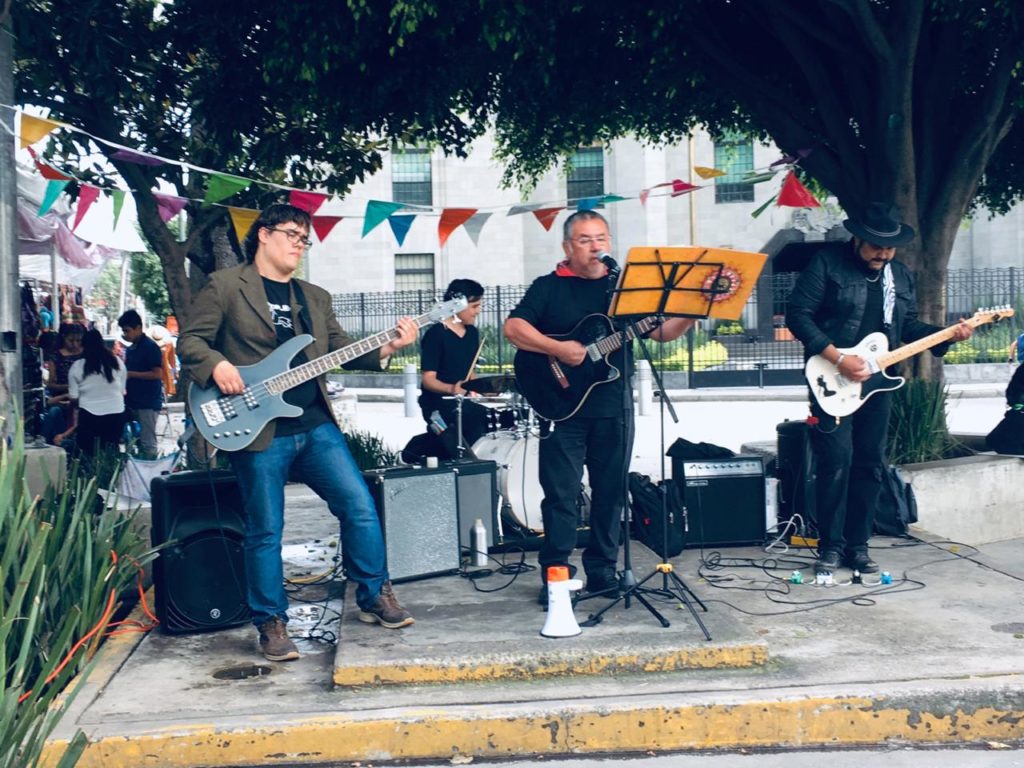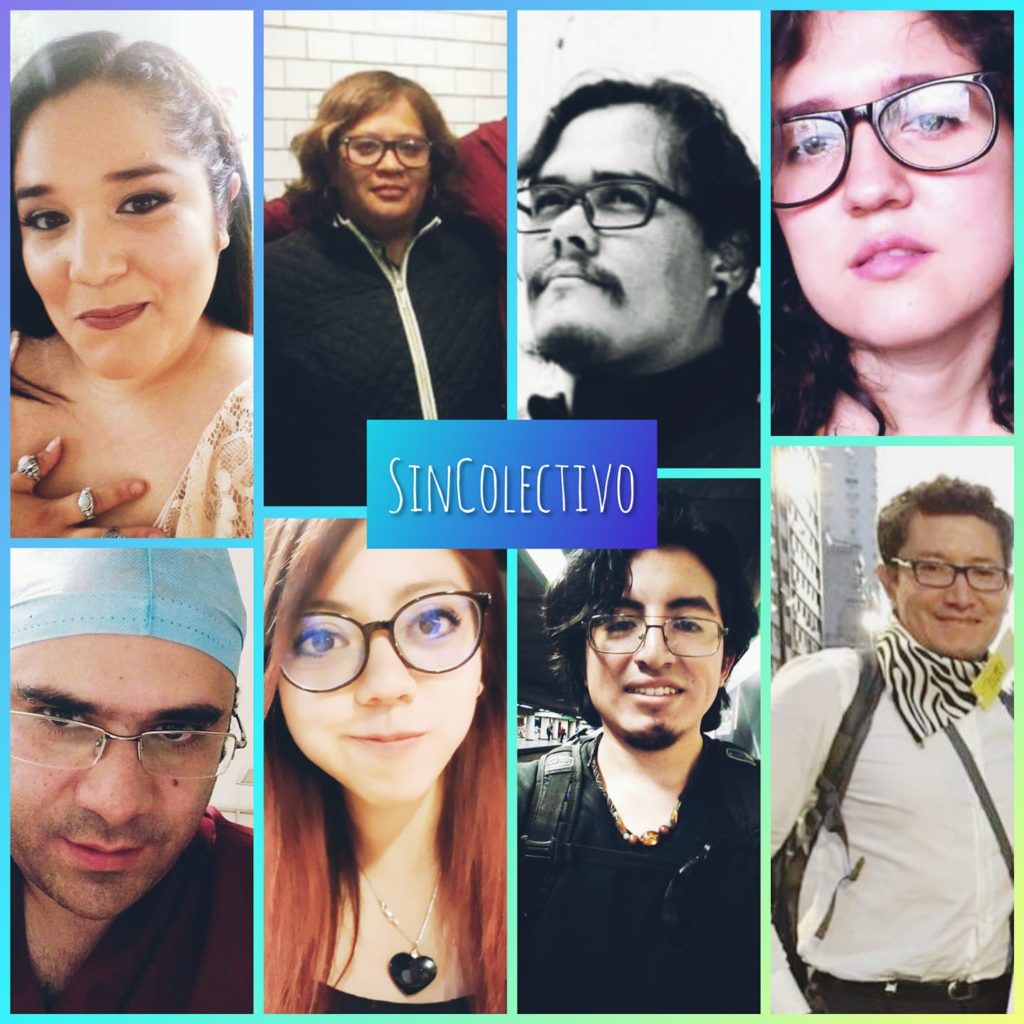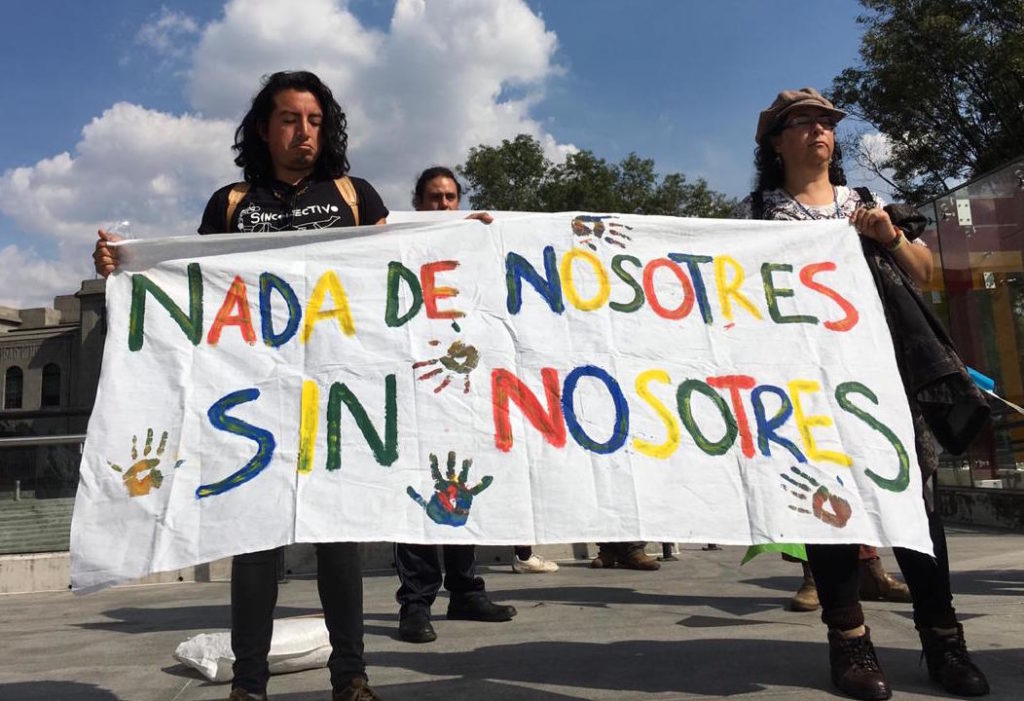On a sunny Saturday afternoon in late July, in the bustling heart of Mexico City, a group of activists gathered at the steps of the Angel of Independence monument, the city’s traditional site of collective celebration. Numbering around 40 or 50, they were a small presence, barely a blip in the life of one of the most populous cities in the Americas. Around them traffic rolled briskly by, drivers oblivious to the gathering. Nearby, a group of teenage girls in quinceñeara dresses were snapping photos of one another, their smartphone fusillades unaffected by their neighbors’ activity. Unknown to the drivers in their cars and the girls in their dresses, an event unprecedented in Mexico’s history was taking place beside them. Mexico’s first Mad Pride march was about to get underway.
Most of those gathered around the monument identified in some way as mad—as neurodivergent, as survivors of psychiatry, as users of psychiatric services—the rest were friends, family, and allies of those who did. Many belonged to activist groups. Most were young, and most were local, though some came from other parts of Mexico.
Around 3 o’clock the marchers set out. The mood was festive, celebratory. Waving colorful placards and sheets bearing brightly-scrawled slogans—“Nothing about us without us,” “We are not against the system the system is against us”—they headed west along the Paseo De La Reforma, a wide tree-lined boulevard, and one of the city’s most important thoroughfares. The road hadn’t been closed to traffic, so they kept to the sidewalks.

As they made their way down La Reforma, people stopped to watch them go by. “Some people supported us,” says Iván Maceda Mejías, a member of Sin Colectivo. “It was mostly positive. We were just a few persons but they were smiling. Some people didn’t know what to think.”
A little less than an hour after setting out, the marchers reached their destination, another monument to Mexican independence, the Estela de Luz. There, beneath the soaring structure of glass and steel, a 14-point manifesto prepared by members of Sin Colectivo was read out loud, in which the dignity and rights of people with psychosocial disabilities was asserted, and ill treatment at the hands of Mexico’s mental health system was denounced. Afterwards a band played a few songs, at which point, about two and a half hours after it started, the march came to an end.
Of the march and the marchers, Víctor Lizama, an activist with the human rights organization Documenta and member of Sin Colectivo, had this to say: “All were mad, but they were powerful. Forty or fifty people. In a city with 20 million persons, nothing, but it was the first time this has been done.”
The first Mad Pride march took place in Toronto in 1993. Organized in response to stigma and discrimination faced by those with psychosocial disabilities, the march was the beginning of a movement that sought to reclaim for their own use words like “mad” and “madness,” terms commonly used to disparage and dismiss people who have received a diagnosis of mental illness or disorder. Since that first march, the movement has given rise to numerous other events around the world—in the U.K., Brazil, Portugal, Spain, France, South Africa, the United States—all taking place under the banner of “Mad Pride.”
In Mexico, where mental health has traditionally been allowed little space in the public consciousness, and garnered even less support from the public coffers, the voices of those deemed mad are seldom permitted to be heard. With only around 2% of the health budget invested in mental health and the vast majority of that allocated to constructing and maintaining the infrastructure of psychiatric hospitals, the priorities of those in power with regard to mental health care are evident.
For the participants in Mad Pride Mexico, the march down La Reforma was a way for a group of people long neglected and subject to discrimination to situate themselves at the center of a conversation that other people—psychiatrists, politicians, even other activists and allies—have been having about them; a way of making their presence felt and their voices heard, not by concealing but by embracing their differences; a way of announcing to society at large that they are people who are able and entitled to speak for themselves. For them, madness must become accepted as part of a public identity, not continue to be, as it is today, a word to be avoided, a condition to be suppressed.
“The word madness is an expression that makes visible that there’s no normality, we use it against stigmatization,” says Maceda, another member of Sin Colectivo.
One of those who read from the manifesto at the Estele de Luz was Gabriela Aragón Zamorano. An actress and member of Sin Colectivo, she received a diagnosis of bipolar disorder at a private clinic in Mexico.

“After this doctor told me I was bipolar I consumed lithium for a year and a half which I didn’t need, then I got with this other psychologist, she did thousands of tests, interviews, and she said no, you do not have bipolar, you have to work, you have to go to therapy, because you were the victim of a lot of things.”
Aragón was fortunate that she could afford another diagnosis. Those without means are not as lucky. “Being mad in the clinical way and surviving is a matter of privilege,” Aragón says. “There are a lot of people on the street that can’t afford treatment, neither private nor public.”
For Aragón, mental health is therefore an issue of equality and justice, an issue for all people, not only those who’ve received a diagnosis.
“Equality is a very big topic that transcends everything. So that most of the time I think that our real agenda right now is to set the basis to say this needs to be not a privilege. This is a right, these are human rights.”
The date of the march, July 27, was chosen deliberately to evoke another date significant in the history of mental health in Mexico, June 27, 1968, the day that Mancomio General La Castañeda was deactivated. (For logistical reasons a June march proved unfeasible.) La Castañeda was Mexico’s largest and most infamous psychiatric hospital. Built in 1918, intended to serve as the centerpiece of a new, modernized health care system, by the time it came down it had become notorious for its degrading and inhumane conditions.
The end of La Castañeda, however, far from ushering in a new era of mental health care in Mexico, meant little more than more of the same. Half a century later and, the odd gesture in the direction of reform notwithstanding, the psychiatric hospital still looms at the center of Mexico’s mental health system. While by far the greater part of a scant mental health budget is devoted to the maintenance and expansion of psychiatric institutions, community-based and alternative approaches go almost entirely neglected.
Meanwhile, as documented in a 2010 report published by Disability Rights International and Comisión Méxicana de Defensa y Promoción de los Derechos Humanos, abuse in mental health facilities is widespread, with this and other reports describing squalid conditions, long-term restraint of inmates amounting to torture, even the use of lobotomies and psychosurgeries on patients for whom the usual course of psychotropics are deemed insufficient.
Inmates of such facilities, in many cases admitted against their will, who lack personal means and have no family willing or able to care for them, are termed abandonados, and their prospects are dim. Many, according to the DRI-CMPDH report, will end up languishing in such facilities for a lifetime, in effect stripped of all legal rights.

“The majority of people who have psychosocial disabilities don’t know they have rights, the right to justice,” says Lizama.
Complicating matters is the fact that, alongside public institutions, a growing number of private facilities have sprung up to fill the gaps left by a public system starved of funds. Such facilities, however, lack government oversight, and their inner workings are often opaque to outsiders. In many cases, as described in testimony last year at the Inter-American Commission on Human Rights, these so-called alternatives to the public system simply replicate the problems of that system.
The central place of the psychiatric institution in Mexican mental health policy has had a decisive effect on the way mental health is understood and responded to in Mexico. Debate over mental health practices has remained largely absent from public discourse, and the institutional approach to care, in which the biomedical model of psychiatry has long prevailed, dominates policy decisions.
Says Lizama, “We in the collective are fortunate. We are supported by our families. But we know this is not the reality in Mexico. They have their freedom taken from them. They are institutionalized.”
Excluded from social, political, and legal spheres, people with psychosocial disabilities have had little say in those policy decisions, decisions that stand to affect them most of all. Those with psychiatric histories have been largely absent from the discussion, and it’s this absence, according to its organizers, that the Mad Pride march was intended to address.
Sin Colectivo, the group behind Mad Pride Mexico, are a collective of eight activists, four men and four women based in Mexico City, dedicated to improving the lives of Mexicans with psychosocial disabilities. Artists, activists, academics, professionals, they hail from diverse backgrounds, but they have in common a lived experience with madness, with psychosocial disability, with neurodivergence. With his or her own approach to how to live with their condition differently, the members are united in the belief that those whom Mexican society has deemed mad deserve a voice, and deserve to have their voices heard.
Moreover, just as each member has chosen how they will relate to their madness—whether they take medication, what mental health services they use, for example—they advocate for all people, in Mexico and elsewhere, to be given the dignity of choice, of choosing how they will relate to their madness, and more fundamentally of how they will live. Their name—meaning Without Collective—alludes to this conviction.
Says Aragón, “I think that is very significant, we are not trying to name ourselves, we are trying to name every single person, this is not just a collective, this is Iván, this is Víctor, this is Gabriela, we highlight the singularities within the collective, and this is very special…The main aim of Sin Colectivo is to open spaces where people are seen as people and to improve the quality of everybody’s life.”
Once Sin Colectivo came together, two events were quickly proposed. One was the Mad Pride Mexico march. The other was a forum where people with psychosocial disabilities could speak out about issues important to them. Billed as the ‘Experts by Experience In Mental Health’ forum, the event was held at the National Library the day before the march.
Explains Lizama, “We invited psychologists, but we wanted to make the protagonists the people with psychosocial disabilities.” While the march itself was conceived as an act of “subversion,” according to Lizama, a way of placing the idea of madness in the public square, the forum served more as a demonstration of the idea embodied in the slogan “Nada de nosotras y nosotros sin nosotras y nosotros”—“Nothing about us without us.”
Says Lizama, “They make decisions in the political sphere, but they don’t take into account our opinion. We want our voices heard, because we are the ones who know what we need.”
Featured speakers were therefore those with firsthand experience—people with psychosocial disabilities, the neurodivergent, survivors of psychiatry, users of psychiatric services—“experts by experience,” in other words, who refuse to remain objects of discussion and judgment.
“The people who came to talk to share their experiences, they were very giving, we had people coming not just from Mexico City but other parts of Mexico,” Aragón says.
Financed almost entirely by members of Sin Colectivo, with some assistance from the National Human Rights Commission, and facilitated by volunteers, the forum addressed a wide range of issues affecting those with psychosocial disabilities in Mexico. Through a series of lectures (“Women, Madness, And Jail: An Intervention Experience”), discussions (“New Approaches to Mental Health and the Right to Life in the Community”), workshops (“Photography and the Construction of Reality from Psychosocial Disability”), and performances, these issues were explored from the perspective of people with actual firsthand experience of them.
“So many people at that forum had these experiences with psychosocial disabilities, with madness,” said Lizama. “It was an exchange of ideas that gave us a wider vision of mental health. It made us realize that there were alternatives.”
Members of Sin Colectivo are already preparing for the coming year, with both a second forum and a second march on the agenda. In the meantime, they are working to strengthen their connections with other activist groups around Mexico as well as international groups in other parts of Latin America.
Looking back on the events of July, members of Sin Colectivo say that in spite of their small scale both the forum and the march exceeded expectations. For Sin Colectivo, Mad Pride Mexico would have been counted as an achievement simply for having taken place at all, but with this year’s success and positive attention in the Mexican press to build on, they believe they can afford to think bigger and now look forward to growing the movement in the years ahead.
Says Aragón, “This year it was small. Next year maybe it will be bigger. We understand that there is a lot of taboo and stigma, and that people are very afraid, but we are trying to make people more comfortable to join us. We need to do this because otherwise people will feel like they are alone.”
****
MIA Reports are supported, in part, by a grant from the Open Society Foundations








Mad Pride in Mexico is Great News!
Report comment
Thanks for the important information.
Report comment
You claim that you are not against the system, that you want to increase the share of psychiatry in the health budget in Mexico, that is to say decrease the relative share devoted to the true medicine, and increase the psychiatric staff:
“We are not against the system”
“only around 2% of the health budget invested in mental health”
“lack personal means”
“scant mental health budget”
“mental health has […] garnered even less support from the public coffers”
In addition, your group is mainly made up of “academics” and “professionals”, that is to say people working in psychiatric companies or institutions and in the spread of psychiatry. This conflict of interest was not fully declared in the article. This is problematic because many members of the group would directly and personally benefit from the increase in the budget of psychiatry in Mexico.
On the other hand, the collective revealed that some of its members consumed psychiatric narcotics, sometimes in massive proportions. This is also problematic because publicly advocating the consumption of toxic products is one way to promote them (Bernays, 1928; Amos, 2000: “Torches of Freedom”). Think about Camel, who interviewed doctors who smoked cigarettes.
Research shows that the increase in psychiatric budgets across history and countries is correlated with a decrease in the recovery rate (Jääskeläinen, 2012), an increase in the suicide rate (Burgess, 2004), and the increase in the mortality of psychiatric patients relative to the general population (Hayes, 2017). Moreover, the increase in budgets is not associated with an effective enlargement of rights.
This indifference to the facts, this sordid obsession to public money, this complacency towards neurotoxins, reflect the corporatist origin of this so-called “patient movement”, actually under the control of people who have a direct financial or professional interest in the development of the psychiatry.
Bibiography:
Amos, Amanda, and Margaretha Haglund. “From Social Taboo to “Torch of Freedom”: the Marketing of Cigarettes to Women .” Tobacco Control 9.1 (2000). Web. 28 Apr 2010.
Bernays, E. L. (1928) Propaganda. Routledge.
Burgess, P., Pirkis, J., Jolley, D., Whiteford, H., & Saxena, S. (2004). Do nations’ mental health policies, programs and legislation influence their suicide rates? An ecological study of 100 countries. Australian and New Zealand journal of psychiatry, 38(11-12), 933-939.
Jääskeläinen, E., Juola, P., Hirvonen, N., McGrath, J. J., Saha, S., Isohanni, M., … & Miettunen, J. (2012). A systematic review and meta-analysis of recovery in schizophrenia. Schizophrenia bulletin, 39(6), 1296-1306.
Hayes, J. F., Marston, L., Walters, K., King, M. B., & Osborn, D. P. (2017). Mortality gap for people with bipolar disorder and schizophrenia: UK-based cohort study 2000–2014. The British Journal of Psychiatry, 211(3), 175-181.
Report comment
Thanks for this. “Mad Pride” is a system ruse and a great way to neutralize true anti-psychiatry activism.
Report comment
Mad pride and antipsychiatry aren’t mutually exclusive in my view. There are circles that can and do intersect. I suppose one could throw a mad pride activist out of one’s antipsychiatry demonstration, but I don’t think doing so would be particularly helpful. The same goes for excluding an antipsychiatrist from your Mad Pride bash. What’s to be gained by that? If it was a system ruse, it would be called Mental Illness Pride (or, worse, Mental Health Pride.) Given the point to which antipsychiatry as a movement has declined, uniting with the Mad Pride movement might be, in my humble opinion, another way to reinvigorate it.
Report comment
My problem with “mad pride”, “neurodiversity”, and similar labels is that they serve only to continue “othering” folks experiencing the normal range of human emotion and reaction.
Trauma did not make me “mad”, “crazy”, or “mentally ill”. Extreme states resulting from adverse experiences should be viewed as part of the spectrum of normal response. I resent the idea that being distressed in response to adversity is something to celebrate. It’s not special, it’s evidence of harm.
Likewise, the altered mental functioning (neuropsychiatric effects) that result from infection and inflammation in the central nervous system from serious physical illnesses like Lyme Disease, syphilis, HIV (even Alzheimer’s is increasingly looking like it has an infectious etiology), is NOT something to be celebrated as “madness”.
Unlike being gay, I wasn’t “born this way” and I certainly won’t give any credence to the debunked biological/genetic theories of “mental illness” etiology by embracing such a position. I refuse to glorify the effects of environmental harm when what is needed is systems change – both in medicine and culturally.
I understand that the labeled population wants better treatment from society in general, but arguing that we’re fundamentally different is a good way to remain targeted for eradication, not inclusion.
Frankly, I think “Pharma Bro”, Jamie Dimon, The Sackler family, Bernie Madoff, The Trumps, etc, are far more dangerous to us societally than the odd “crazy” who does something sensational. How much press does one person being pushed in front of a subway train deserve when despotic wealth hoarders are screwing us all while smiling and gladhanding? I’m going to guess that far more deaths and misery are associated with the names above than with the one off stories that hog media attention and cause distressed folks to remain targeted as some kind of massive danger to society.
No, I won’t fight for “mad pride” and I don’t see it as being particularly compatible with antipsychiatry. Given my own circumstances, I’m a shining beacon of normality and goodness, so I will not participate in my own othering and beg for acceptance of my supposed “madness”. Fighting for systems change is my only focus.
Report comment
I resent the idea that being distressed in response to adversity is something to celebrate. It’s not special, it’s evidence of harm.
KS kicks ass from an undisclosed location! We’re proud of you even if you aren’t “mad,” KS 🙂
Report comment
Well said, kindredspirit. I agree, getting rid of the evil systems is what is needed.
Thank you for pointing out the conflicts of interest and fraud of this group, Sylvain.
Report comment
Would you try to establish a bell curve for behavior, and make all at the center of the curve “normal”, and all at the edges “extreme”? I dunno. Sounds a little scary. French surrealist, Rene Magritte, in one of his illustrations, depicted people as coffins. I don’t, for one, equate “normality” with “goodness” any more than I equate politicians with truthfulness. Conformity and drudgery don’t always seem like the way, if you had a way, to go. I’m not shy. I embrace my madness, and I want to express it. I’m not too keen on being pigeon holed in a pine box.
Mad Pride, fundamentally, is about tolerance and acceptance of our eccentricities and our differences. I don’t have a problem with those eccentricities and differences. Perhaps you do. I think there should be a place to express them, and therefore, I enthusiastically welcome Mad Pride and the mad movement. Segregating people, and locking them up, for being different just isn’t my idea of a good time. Letting them be themselves, and, spontaneously, do what they would do? Now you’re talking.
Report comment
Re-read Sylvain’s post. Actually anti-psychiatry thought is gaining traction, as can be seen by comparing MIA comments from 5 years ago to those today; you’ll see that in a number of ways what was once considered “extreme” has become platitudinous.
Report comment
Antipsychiatry comes and goes, but nobody can manage to kill it off because it’s a Phoenix bird. As long as the system is about, and mostly about, violating human rights there will be a place for antipsychiatry. That said, it is not in a better place than it was say 30 years ago when nobody was calling “antipsychiatry” a label, falsely accusing it of “negativity”, and before the “mental patients” movement had turned on it. Today, it still has a pulse, due to a few professionals and an endless supply of “in your face” ex-patients. As long as “treatment” is damaging and forced, it will have a future. The same cannot be said for psychiatry.
Report comment
Again, oldhead sees clearly. Nonsense such as “mad pride” threatens the real work of antipsychiatry, namely the abolition of psychiatry. What next, idiot pride? Stupidity pride? Foolishness pride? We already have enough of that, and it’s not something to be proud of.
Report comment
Well, I see nothing wrong with nonconformity pride. I figure we could use a lot more of that.
I’m with Szasz on one matter, abolition of involuntary hospitalization. Why should I care about what psychiatry is up to if it can’t be forced upon me against my will and wishes? Abolition of psychiatry? I’m not sure what that means. Prohibit a profession? Well, okay. You do that. I will work on ending human rights abuses and forced maltreatment instead.
Stupidity pride, idiot pride, foolishness pride…Why not? Let’s hear it for not wising up.
I tell you what. I imagine we have a lot of antipsychiatry pride here. Let’s hear for, wise or ignoble, antipsychiatry pride.
Now let’s hear it for freedom, freedom to be oneself. That’s what mad pride is all about for me, and I wouldn’t have you taking it away from me for anything in the world. Sorry.
Mad power…Its coming whether you like it or not. Just sit back, and get used to it.
Report comment
Sylvain–
From one US citizen, survivor of mental hospitals, and long-time activist who attended this conference, you are dead wrong with most of your opinions about this group and their intentions.
There are many cultural differences between the US and Mexico with regard to people with mental problems. Family brutality is higher in Mexico. Stigma is much greater.
Perhaps you need to reread this article with open eyes, not judgments and projections.
For example, the privilege of participants was acknowledged. When someone is struggling to survive, they don’t have the time to go to such a conference or march. I dare say that is what US peer support systems and even MIA has become–institutions of individual class privilege and often of exclusion.
Some of what you are interpreting might be language differences, or ones of history.
Mexican history is so full of oppression that it has become normalized and institutionalized–to a far greater degree than in the US. Most people just expect it as a part of normal living, go on with their lives, doing nothing to stop it.
Perhaps after rereading the article, you may elect to remove your comment.
Report comment
I know they’ve had Mad Pride celebrations in South America, in Sao Paulo in particular. Now Mad Pride (el orgullo loco) has come to Mexico. May it have many happy returns. What the world needs, together with less boredom, is more flamboyance and eccentricity, and with it, more tolerance. Way to go Mexico City! Continue to be, mad, and proud.
The idea of “psycho-social disability” is a bad joke though. This matter hinges on somebody convincing you that you are “dysfunctional”, and if you buy it, the joke is on you. Give a person a reason, a purpose, and you’ve just given the shove to “dysfunction”, and with it, “psycho-social disabilities”.
“Yeah, sure, I agree. We should do that more often.”
Report comment
When I think of the sacrifices that have been made in the name of science (“well we know not to do THAT any more”) something from the bottom of me rises up and says “NO” How did you not know not to do that in the first place. I remember standing on the Hopi reservation and a missionary was passing out pamphlets explaining that sexual abuse was wrong. “They don’t know that it’s wrong” he said. How do you not know it’s wrong? No one needs to tell you it’s wrong for you to know it’s wrong. And science… Keeps coming up with weirder drugs and weirder “treatments” when what we really need is a hug. Who doesn’t know that? Who needs decades of research and data to find out not to create offenses against humanity and put them in people. Bah Science.
Report comment
Removed for moderation.
Report comment
The idea of ~mental illness~ is in and of itself severe abuse. The only thing one might be proud of is if they have been able to win a legal victory against the ~mental health~ system.
Report comment
Fortunately the Latin Civil Law Countries have not been as effected by Psychotherapy as the Anglo Saxon Common Law Countries.
I certainly hope that we are not exporting Psychotherapy!
Report comment
Mad Pride has got to beat mad humility, shame, cowardice, and defeatism. I don’t have a problem with people bristling and showing their colors. Given a choice between doing something, and not doing anything, count me in there with the marchers. If you think you’ve got it, flaunt it, because forever holding your peace should not be an option. It’s good that Mad Pride has come to the streets of Mexico City. May this be the first such event, and certainly not the last. I hope you have another parade scheduled for next year, the year after, and the year after that. I would hope that people will grow more tolerant of human differences once they have been exposed to them. Keep up the momentum, and let’s watch this thing strengthen and grow. Thank you for this post, and for doing your part to give this world what it is lacking.
Report comment